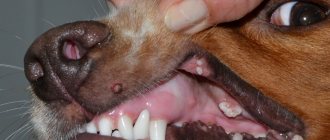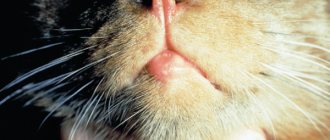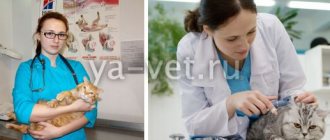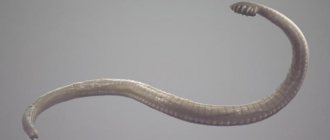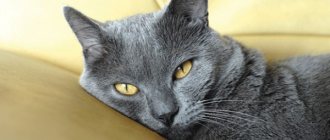Hyperthyroidism in cats develops quite often; it is a pathology of the endocrine system, which directly depends on the excessive production of two hormones by the thyroid gland of a mustachioed pet: thyroxine and/or triiodothyronine. In dogs, this disease is much less common than in cats. Therefore, if you are the owner of a small tabby, read this article carefully and find out why hyperthyroidism develops in cats and how to treat it.
Hyperthyroidism in cats: symptoms and treatment
What is hyperthyroidism in cats?
To understand what the disease we are interested in is, it is enough to consider the components of its name. So, let's break down the name “hyperthyroidism” into parts:
- part No. 1: the word “hyper” translated into Russian means “excessive” or “above the norm”;
- part No. 2: the word “thyroid” is translated as “thyroid gland”.
Putting both syllables together, we understand that we are talking about the overly active functioning of the thyroid gland in cats, which in these animals works almost the same way as in humans.
The structure of the feline thyroid gland is similar to the human one in many respects.
In cats, this organ consists of two lobes, which are located on both sides of the cat's trachea. They are responsible for the production of the hormones we mentioned in the introduction:
- thyroxine;
- triiodothyronine.
In 70% of all cases of the disease, one or both lobes of the gland increase in size under the influence of some factors and begin to produce much more active hormones.
Causes of hyperthyroidism
There can be various reasons for the development of hyperthyroidism in cats. This deviation cannot occur on its own and is always a continuation of the primary disease.
The most common cause of hyperthyroidism is the formation of a benign or malignant tumor inside the cat's thyroid gland, which affects the production of hormones.
Table. Causes of hyperthyroidism in cats
| Cause | Description |
| Thyroid adenoma | Most often, the main cause of the development of a disease such as hyperthyroidism is the presence in the cat’s body of an adenoma - a benign formation that has grown inside one of the elements of the endocrine system of the animal’s body - the thyroid gland. As an adenoma develops, the gland increases in size and becomes like a bunch of grapes that inappropriately grew in a cat’s throat. In more than half of the cases of pathology in cats, both lobes of the organ are affected |
| Thyroid adenocarcinoma | Adenocarcinoma is also a neoplasm, but, unlike adenoma, it is malignant, formed by the glandular cells of the organ. Such a disease is much more serious than adenoma, although it affects the same organ and, in the opinion of a person without veterinary education, is not particularly different in appearance. However, the cause of hyperthyroidism is adenocarcinoma in approximately 2% of all cases of seeking help from a veterinary clinic. |
However, despite the discovery of a connection between the diseases mentioned above and hyperthyroidism, the general etiology of the disease has not been clarified. Thus, antibodies that stimulate the production of:
- thyroxine;
- triiodothyronine.
To confirm the diagnosis, it is necessary to take blood from the cat for analysis.
There is an opinion that nutritional factors (caused by poor nutrition of the animal) have a great influence on the development of the disease in question. For example, it is believed that industrially produced canned food contains:
- in excess amount of iodine;
- traces of fertilizers or fertilizers themselves in small quantities;
- herbicides of various properties;
- insecticides, etc.
In addition, the theory that the breed of cats can also have a certain influence on the development of the disease of interest to us has not been proven, but is presumably also considered true. Thus, it has been noted that the least predisposed to hyperthyroidism are the following cat breeds:
- Siamese;
- Himalayan.
Siamese cat
Himalayan cat
As you know, both of these breeds have common genes, because the Himalayan cat was bred using animals:
- Siamese breed;
- Persian breed.
Perhaps it is the common genes of these cats that determine resistance to hyperthyroidism and the diseases that cause it.
The concepts of hyperthyroidism, hyperthyroidism and thyrotoxicosis
The thyroid gland is a butterfly-shaped organ located between the collarbones and larynx. It performs an intrasecretory function, that is, it produces special hormones that regulate metabolism:
- triiodothyronine, or T3;
- thyroxine, or T4.
In addition to metabolism, thyroid hormones are responsible for oxygen transport and heat exchange. A change in their normal quantity affects the condition of all internal organs.
The mechanism of development of hyperthyroidism is accompanied by an increase in hormone levels and a subsequent acceleration of metabolic processes. This is accompanied by increased stress on the heart, musculoskeletal system and gastrointestinal tract.
When mentioning the disease, the terms “hyperthyroidism” and “thyrotoxicosis” are often used. The first term means excessive thyroid function and can be synonymous with the disease itself. In English these terms are identical.
But thyrotoxicosis in cats refers to the consequences of an excess amount of hormones. They are not always associated with disorders within the organ, so it is inappropriate to use this term as a synonym.
Cats at risk
Cases of the disease of interest to us were noted in each of the age groups of the animals under consideration, however, it was revealed that middle-aged and elderly cats are most often affected by the disease. Thus, upon reaching 6 years of age, a cat is at risk for the disease, with the average age of the disease being 12-13 years. It often happens that hyperthyroidism becomes the very last illness of your cat.
Older cats are at risk
However, it should be noted that, despite the fact that there is a connection between the age category of animals and morbidity, there is no dependence on:
- gender;
- pregnancy in cats;
- puberty;
- other features.
This is why it is very important to visit the veterinarian more often over time, so as not to miss the moment when your cat develops hyperthyroidism.
Enlarged thyroid gland in cats with hyperthyroidism
How and with what to treat
Some owners believe that there is no point in treating hyperthyroidism, because their pet is already old. Undoubtedly, this is the business of the owner himself. But here are the consequences this disease can have.
If left unattended, hyperthyroidism can lead to heart failure, and due to constant high blood pressure, there is a risk that the retina of the eye will begin to detach, various kidney diseases may also develop, and the cat will lose weight. All this will cause a lot of suffering to the animal until it dies.
After a diagnostic examination and confirmation of the diagnosis, the most effective course of treatment for a particular animal is prescribed, depending on the patient’s condition and the severity of the disease. Treatment of hyperthyroidism can be carried out using various methods.
Drug therapy. Treatment consists of taking antithyroid drugs. To date, the most effective treatment for this disease is methimazole. The effect of taking the drug occurs within the first two weeks after oral administration
But it is important to remember that any of the most effective pills have side effects. According to statistics, about 15% of cats after taking methimazole experience drowsiness, vomiting and loss of appetite
If a kitten swallows a tablet higher than the recommended dosage, blood cells may be destroyed, the blood may clot, jaundice may develop, and itching on the face may appear. If any of the side effects occur, the drug is immediately discontinued, and then other more radical methods of treatment are used. Surgical method. Feline hyperthyroidism is usually accompanied by a benign encapsulated tumor of 1 or 2 lobes of the thyroid gland. Surgical treatment involves complete removal of a benign tumor. After the operation, the pet feels great and is recovering quickly. Before surgery, anesthesia is used, which is difficult for cats to tolerate. It is important to understand that anesthesia can negatively affect the condition of the animal’s heart, kidneys or other organs. The cost of using the surgical method is quite high. But on the other hand, a more effective solution would be to remove the tumor rather than constantly paying for tests and buying drugs for treatment. Radioactive iodine therapy. Treatment with radioactive iodine is considered the best modern method in terms of effectiveness and cost. The essence of this method of treating hyperthyroidism is a single subcutaneous injection. Radioactive iodine introduced into the animal's body enters the thyroid gland, where it has a destructive effect on diseased tissue. As a result, radioactive iodine becomes the main factor in hyperfunction of the gland.
The modern type of therapy is completely safe for the health of the animal, as it does not require anesthesia or surgical intervention. After the procedure is introduced, the animal is under the supervision of veterinarians for 1-2 weeks.
Unfortunately for some animals, owners do not always decide to begin treatment for hyperthyroidism in a cat, justifying themselves by the fact that the animal is already of advanced age. In this case, we dare to remind you that the lack of treatment will not only hasten the death of the animal, but before its death it will also have time to lead to the appearance of:
- Congestive heart failure
- Chronic diarrhea
- Kidney diseases
- Retinal detachment
- Critical weight loss
If treatment is started on time, then the prognosis of veterinarians is quite favorable. It worsens only in cases of poor general physical condition of the animal or if the cat has a concomitant disease. Here, the normal dynamics of treatment directly depends on the animal’s reaction, which in each individual case manifests itself purely individually.
Clinical picture of the disease
Overactive functioning of the cat's thyroid gland, which also causes increased activity of metabolic processes in the body, affects absolutely all its systems. However, from the point of view of clinical manifestations, despite its systemic nature, the disease is often completely invisible, that is, its symptoms develop over a very long time and very slowly. So slowly that some owners mistake the first signs of the disease for natural echoes of the aging process of their animal and do not take any measures to eliminate them.
Any owner can recognize that a cat’s thyroid gland is overly enlarged.
Most often persecutes animals with hyperthyroidism:
- sharp weight loss, which occurs against the background of the same or even increased appetite;
- frequent urination;
- severe thirst and constant drinking of water;
- changes in the structure of the coat, its loss, fading;
- excessive nervous excitement, irritability;
- involuntary trembling of the limbs and body as a whole;
- loose stools or other changes associated with stool;
- tachycardia;
- cardiac cough;
- nausea and vomiting;
- changes in the thyroid gland;
- sometimes complete exhaustion.
When examined by a veterinarian, the first factors that strike the eye in case of hyperthyroidism are exhaustion and poor appearance of the coat.
So, in almost one hundred percent of cases with this disease, changes in the structure of the thyroid gland are detected. When examining the heart muscle, various pathologies are revealed, for example:
- increased heart rate;
- noises that occur in the interval between the first and second heart sounds during ventricular contraction;
- strengthening the so-called apical impulse, etc.
An X-ray examination of the animal may also reveal a pathological increase in the size and weight of the heart due to excessive primary damage to the heart muscle. In addition, sometimes X-rays reveal:
- cardiac muscle failure of congestive type;
- effusion into the slit-like space between the layers of the pleura.
Unfortunately, hyperthyroidism cannot be treated without examinations at a veterinary clinic.
Laboratory studies of biological fluids in cases of hyperthyroidism in cats show no pronounced changes. So, for example, a general blood test of an animal shows erythrocytosis, a biochemical analysis of the red liquid can show:
- increased levels of liver enzymes;
- excess content of nitrogenous metabolic products excreted by the kidneys;
- hyperphosphatemia, etc.
To confirm the truth of the proposed diagnosis, the total amount of thyroxine in the blood serum is measured. In this case, the presence of the hormone triiodothyronine may not be examined, since it is believed that the determination of this indicator cannot improve the level of quality of the diagnostic process. In addition, sometimes with elevated thyroxine, the amount of triiodothyronine can be absolutely normal. That is why, if you first determined the presence of triiodothyronine and it is normal, but suspicions about the presence of hyperthyroidism remain, re-test the total amount of thyroxine.
Life with hyperthyroidism is possible with constant supportive drug treatment
Please note: sometimes the clinical picture and tests of a cat indicate that she has diabetes mellitus. In this case, it is also necessary to check for the presence of hyperthyroidism, since these ailments are very similar and can occur simultaneously.
Diabetes mellitus in cats
When should you contact a veterinarian?
The main symptoms of hyperthyroidism are:
- increased appetite;
- sudden weight loss;
- increased thirst;
- frequent urination;
- diarrhea (diarrhea);
- vomit;
- matting or hair loss;
- aggression, excessive activity and constant restlessness.
Any suspicion of hyperthyroidism in cats should promptly seek veterinary attention. Otherwise, your pet may develop chronic diarrhea, heart failure, eye or kidney disease. In advanced cases, a sick cat may die.
When carrying out drug therapy, you should not self-medicate. You must always follow all the requirements and recommendations of a specialist. You also need to strictly ensure that the animal receives the prescribed medications in a timely manner and in the required dose.
But there are special cases when, for example, hyperthyroidism occurs in a 16-year-old cat, there can only be one prognosis - death. After all, the animal is already at an advanced age and may not be able to endure the operation, and drugs that will have a bad effect on the already worn-out kidneys will quickly “bring” the animal. In this case, it is better not to take treatment; perhaps this way the cat will live even longer than with the use of medications.
Treatment of hyperthyroidism in cats
Treatment of the disease in cats is usually aimed at reducing the activity of the production of hormones mentioned earlier, which cause the development of hyperthyroidism.
Hyperthyroidism is a non-contagious disease, so you don’t have to worry about one of your pets passing the disease on to another
Interestingly, for cats, as for people, there are several methods of getting rid of this disease, namely:
- radiotherapy using the iodine-131 isotope;
- surgery (thyroidectomy);
- treatment with drugs.
Therapy using iodine isotopes for hyperthyroidism is very justified. Moreover, it is considered one of the safest methods, and at the same time truly effective. However, this method assumes:
- low availability;
- availability of complex technical support.
In other words, this method is hardly available today on the territory of the Russian Federation. Perhaps exceptions will be made in the capital's veterinary clinics, but regional animal hospitals cannot offer such services.
Treatment that involves surgery is carried out only if there are no contraindications
This method of treatment is very effective, but it is necessary that the surgeon performing the operation has similar experience, since, provided that the parathyroid gland is accidentally damaged or completely removed, the consequence may be a pathological decrease in the level of calcium in the blood plasma. You may also experience:
- Horner's syndrome (damage to the visual apparatus);
- laryngeal paralysis.
Unfortunately, veterinary medicine in Russia is at an insufficiently developed level, therefore, most likely, when you turn to a veterinary clinic for help, you will be offered treatment in a conservative way, that is, with the help of medications. Drug therapy requires a long duration, but still remains the most common method of treating hyperthyroidism in our country. However, it is not capable of completely healing the animal.
Hyperthyroidism is a disease that can occur in both outdoor cats and pets.
In the treatment of hyperthyroidism, drugs based on thiourea are widely used, containing substances such as:
- thiamazole;
- methimazole, etc.
These substances have an inhibitory effect on the production of thyroid hormones. Antithyroid drugs prevent iodine from attaching to thyroglobulin and reduce the production of:
- trioxin;
- triiodothyronine.
Please note: self-prescribing these drugs to a pet is completely excluded and strictly prohibited, since human remedies are used to treat cats, many of which are not suitable for animals and may not only not cure, but also kill the cat.
Self-treatment is prohibited
Beta blockers are also used as one of the means of complex treatment, which help eliminate or stop dysfunction of the heart muscle. Provided that thyroidectomy (surgery) is performed, the use of beta blockers is mandatory.
Please note: if, upon contacting the veterinary clinic, your animal was prescribed ongoing medication treatment, you should be prepared for the fact that taking them will become an integral part of your life until the cat dies of old age or you find a way to way to carry out surgical treatment.
If your cat's hyperthyroidism is caused by cancer, you will most likely have to treat your cat with anti-cancer medications as well. The malignancy of the tumor will seriously complicate the treatment process and make it longer, but, nevertheless, oncology in cats is not a death sentence, and you can cure your pet if you put in the effort. However, it should be understood that even surgical removal of the tumor will not eliminate the disease, and we are talking not only about cancer, but also about hyperthyroidism.
Oncology in cats is not a death sentence
Treatment options
It is believed that all breeds of cats are equally susceptible to the disease, males and females may be equally likely to suffer from hyperthyroidism, but this disease rarely affects young animals. Most often, the disease is observed in cats over 12 years of age, which suggests that the cause of the development of hyperthyroidism may be age-related changes in the functioning of the hormonal and endocrine systems of cats.
Treatment is selected by a veterinarian individually for each specific situation based on the general health and age of the animal, as well as the severity of the disease. Treatment can be carried out using the following methods:
- by taking tablets orally. The “gold standard” of drug treatment with tablet drugs is considered to be taking drugs such as Methimazole. This is a high-quality and effective remedy that ensures a reduction and complete disappearance of signs of hyperthyroidism literally within a couple of weeks of use. Unfortunately, the drug may be poorly tolerated. Up to 20% of all animals taking Methimazole tablets suffer from side effects. They are expressed in the form of nausea, vomiting, loss of appetite, lethargy and drowsiness of the animal, itching (especially on the face), jaundice and problems with the formula and condition of the blood. If the symptoms are mild, you can continue taking it, but if the cat cannot cope with the side effects, you will have to stop taking the drug, since it must be taken daily and for life. The presence of side effects is a serious obstacle to the treatment of hyperthyroidism with oral drugs;
- in the presence of tumors (malignant or benign), the only way to combat the disease is surgery. The operation is not cheap, but it contributes to the rapid recovery of a sick cat. In addition, owners will not need to constantly monitor the level of thyroid hormones in the cat’s blood and give it daily medications that can worsen its condition. The only difficulty and danger is the effect of anesthesia on older animals. In this case, there is a risk that the pet may not “come away” from the anesthesia and die;
- the use of radioactive iodine in the form of subcutaneous injections is one of the most modern, effective and promising methods of treating hyperthyroidism. And there are a number of difficulties here, but they all pale in comparison to the radical nature of this method. Cure may require just one injection, and the cat will not need to be given any further treatment for the rest of its life. But you will have to pay for this, and a lot, on average up to 800 US dollars, and the animal must be kept in the clinic for about two weeks. This is necessary so that radioactive iodine, having completed its work in the thyroid gland, is removed from the cat’s body. Despite the exorbitantly high cost of the procedure, it is completely justified, since the cat no longer requires any treatment. If we add up all the costs for medications, tests and visits to veterinarians during the animal’s life, then the amount will be much greater than the one-time costs of radiotherapy.
The choice of treatment depends on the age of the cat and the severity of the disease, as well as the presence of other aggravating factors. The type and method of treatment is chosen by the veterinarian, who bases his decision on the results of the tests obtained. With correctly chosen and adequately carried out treatment, the animal can safely live a long, full life.
For the health of your pet, it is very important to be extremely attentive to its behavior, nutrition and coat condition. These simple indicators, if they change, should immediately alarm the owner and lead to a visit to the veterinary clinic
Sometimes this simple common sense decision can save the life of an adorable furry friend.
Let's sum it up
Hyperthyroidism in cats is a common disease that owners of furry pets often have to deal with. You need to understand that a cat with hyperthyroidism, especially caused by an adenoma, can live a long and quite happy life, so there can be no talk of any euthanasia.
If hyperthyroidism is detected, you need to enlist the support of the best veterinary doctor in the locality in which you live, since only in this way will you be able to gain some confidence in a positive outcome of the case. Remember: your pet really needs the love and support of its owners while fighting the disease. Give them to him and you will be rewarded with the same loyalty in return.
Thyroid crisis
It is a term used in humans to describe an acute exacerbation of clinical signs of thyrotoxicosis combined with varying degrees of organ decompensation. The cause is thought to be an increased cellular response to thyroid hormone combined with increased or sudden availability of currently available thyroid hormones.
Thyroid crisis is usually precipitated by stroke, infection, thyroid surgery, other non-thyroid diseases or withdrawal from thyroid drugs (Chiha et al, 2013).
Diagnosis is based on the manifestation of four main clinical signs: fever, central nervous system (CNS) involvement, gastrointestinal or hepatic dysfunction, and cardiovascular effects such as tachycardia, atrial fibrillation, and congestive heart failure. Although cats with hyperthyroidism may have exacerbation of clinical signs either due to complications of thyrotoxicosis (eg, congestive heart failure, hypertension) or the presence of concomitant nonthyroidal diseases, thyroid crisis, as defined in humans, has not yet been described in cats (Ward, 2007 ; Tolbert, 2010).

